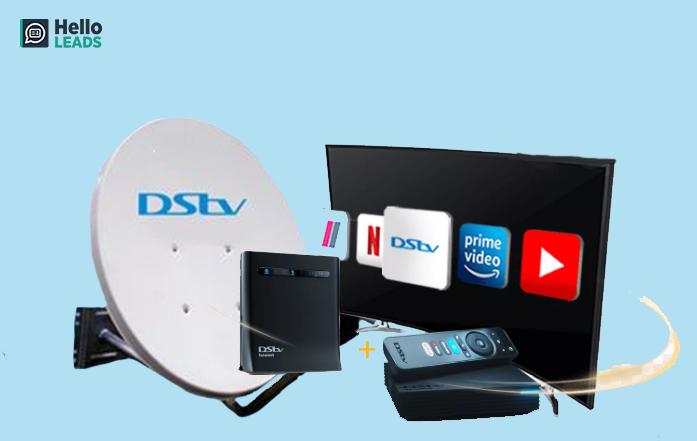DStv: Your Guide to Installment, Setup, and Troubleshooting
DStv's satellite tv service uses a variety of bundles customized to varied seeing preferences, yet the journey starts with a correct installation and configuration. Recognizing the nuances of dish placement, decoder links, and initial configuration is critical for optimal performance. Furthermore, fixing usual problems can conserve time and improve your watching experience. As we discover these aspects, you may find that the options are extra accessible than you expected, yet some ins and outs call for closer exam to make certain smooth procedure.
Comprehending DStv Packages
Comprehending DStv packages is vital for maximizing your watching experience and guaranteeing you select one of the most appropriate choice for your needs. DStv offers a range of plans customized to different choices and spending plans, making it critical to analyze their offerings meticulously.

Along with carry selection, DStv bundles may additionally include attributes such as the ability to document programs, pause real-time tv, or access on-demand web content through DStv Catch Up. It is a good idea to consider your viewing routines and the sorts of material you value most when picking a package. Performing extensive study and comparing the offered alternatives will certainly ensure you make an informed decision, inevitably enhancing your entertainment experience.
Setup Refine
The installation procedure of a DStv system is important for ensuring optimum performance and a seamless viewing experience. To start, it is vital to pick a suitable place for the dish antenna, considering elements such as view to the satellite, marginal blockages, and ease of access for upkeep. The meal needs to preferably be mounted on a durable surface, such as a wall or pole, at a height that decreases disturbance.
Following, the installment of the LNB (Reduced Sound Block downconverter) is essential, as it obtains signals from the satellite. Correct alignment is essential; the meal should be adapted to the correct elevation and azimuth angles for exact signal function. Making use of a signal meter can substantially help in accomplishing ideal positioning.
After the meal and LNB are safely mounted, the coax should be attached from the LNB to the decoder - DStv. It is critical to ensure that all links are tight and secured to protect against signal loss or interference. Lastly, the system must be powered on, and preliminary checks carried out to confirm that the installation has achieved success before proceeding to the configuration stage.
Preliminary Setup Actions
Once the installment procedure is complete and the devices is effectively established up, visit this site right here attention turns to the initial setup actions called for to configure the DStv decoder for optimal viewing. Begin by connecting the decoder to your television using the proper HDMI or RCA cables. Guarantee that all read review links are protected to prevent any type of signal disruptions.
Following, power on the decoder and television, selecting the proper input source on your television that corresponds to the connection used. Comply with the on-screen triggers to establish the language choices and proceed to the satellite configuration. The decoder will instantly check for available satellite signals, which might take a couple of minutes.
Once the scan is complete, verify that the signal stamina and top quality are satisfactory. If the signals are weak, change the satellite dish placement as required. After validating a secure signal, finish the installation by triggering your DStv registration, which frequently involves going into a smart card number and adhering to extra motivates.
Typical Repairing Tips
When encountering problems with your DStv decoder, it is necessary to approach troubleshooting methodically to determine and fix the trouble successfully. Begin by examining the power supply; make sure that the unit is connected in and the power outlet is functional. If the decoder is powered but reveals an empty display, confirm that the tv is readied to the right input source.
Next, inspect the satellite dish positioning and the cable television connections. A misaligned dish or loose cables can lead to signal loss. If you notice the signal stamina is reduced, think about repositioning the meal for optimal alignment with the satellite.
For decoder-related errors, reactivating the system can often settle short-lived glitches. Simply unplug it for a couple of seconds and afterwards plug it back in. If you receive particular error messages, refer to the individual handbook for assistance on troubleshooting those codes.

Maintenance and Support

One more necessary aspect of maintenance entails upgrading your decoder's software. DStv occasionally releases updates that boost performance, protection, and accessibility to new attributes. Preserving an updated system not only optimizes your decoder's capabilities yet likewise provides accessibility to the most recent content and capabilities.
For recurring assistance, DStv supplies different sources, consisting of click site customer solution hotlines and on-line troubleshooting overviews. Engaging with these assistance networks can help customers in solving common concerns properly. In addition, think about enrolling in service strategies that provide professional upkeep checks and technical support.
Verdict
Finally, a thorough understanding of DStv packages, combined with correct installation and arrangement procedures, is important for ideal seeing experiences. Sticking to typical troubleshooting tips and taking part in normal maintenance even more improves service reliability. Making use of available consumer support sources can supply useful support in settling any kind of problems that may emerge (DStv). Ultimately, complying with these guidelines ensures that customers make the most of the benefits of DStv's satellite tv offerings, causing a much more pleasurable and continuous watching experience.